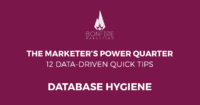No marketer is fully armed without access to Google Analytics and Google Search Console. Combined, these two platforms are powerful tools that provide insight into your organic traffic and content marketing efforts.
In this week’s Metrics Monday we walk through setting up Google Search Console, integration with Google Analytics, and how to analyze the reports for content optimization opportunities and ideation.
Steps for Google Search Console setup and verification
You need both a Google Analytics account and a Search Console account to get started. Setting up a Search Console is painless and does not require a developer. Here are three easy steps for setup:
1. Originally called Google Webmaster Tools, navigate to http://www.google.com/webmasters/tools.
2. Sign in and add your site.
3. Verify the site is yours. There are different ways to verify ownership, requiring different levels of technical knowledge. If you can, use the recommended method of uploading an HTML file to the root directory of your site. If you can’t, the easiest alternative is to use your Google Analytics account if you already have one and have “edit” permissions for it. For this to work, your GA tracking code must be within the site’stag and not thetag.

Pro tip: Add all variations of your site, like www and non-www, and any subdomains, like shop.yoursite.com, as Search Console Properties.
How to integrate and configure Search Console with Google Analytics
Login to your Google Analytics account, and go to the Admin tab. At the Property level, select Property Settings from the menu and then the button for Adjust Search Console. Click on the Edit text link, hit the radio button for your Search Console account, and Save.
A well-optimized Google Analytics account should have multiple views. Next, decide if you’d like to see Search Console data in all views or specific views, and Save.

4 content optimization insights with Search Console reports
Now you’re ready to analyze your Search Console reports within GA. You can find the four dimension reports under Acquisition in the lefthand menu: Landing Pages, Countries, Devices, and Queries.

Each report includes impressions, clicks, click-through rate (CTR), and average position as metrics, which you can analyze in relation to engagement metrics, like bounce rate, and your custom goals.
Remember: While you can’t segment your data in the Search Console reports, the data is unique and valuable because it focuses solely on your organic traffic for the past 90 days and no other channels.
Here are four ways to use Search Console data in Google Analytics to boost your content performance.
1. Landing Pages
With the Landing Page report you can hone in on:
- Which web pages or blog posts are appearing in Google search results.
- Which keyword phrases are sending you organic traffic.
- Which landing pages have the strongest CTRs.
- And which pages are increasing site engagement and goal conversions.
So how do you optimize your content using the Search Console Landing Pages report? First look for pages with a high number of impressions, but low clicks and CTR. Next, pull up the title tags and meta description of these pages and strengthen them.
Organic traffic growth and engagement metrics are crucial for SEO performance monitoring. Blog posts with a high bounce rate indicate you’re not meeting searcher’s intent and need to optimize them further.
If your home page has a low page depth, audit the page and the site’s navigation for user experience improvements.
2. Countries
Unless your audience is international, you won’t find much useful information in the Countries report. Though if you do notice positive traction and interest from a specific country, consider publishing more content targeting that location. Or it may be time to explore international SEO and language-specific content.
You can drill down to see what content (landing page) is popular with a specific country by selecting the country name.
3. Devices
The coolest insight from the Devices report is learning how content performs in organic search from device to device (desktop, mobile, and tablet). And you’re able to compare engagement results between devices.
4. Queries
The introduction of secure search and “(not set)” or “(not provided)” data by Google was one of the top three changes to search marketing in the past five years. It was a blow to SEO, but hey — we survived and are smarter because of it. The Queries report doesn’t tell all, but paints a clear picture of what keyword phrases are sending organic traffic to your site.
Queries is the one report that does not integrate with Google Analytics behavior or goal metrics. You can still view clicks, impressions, CTR, and average position for each search query. You can add a secondary dimension for device and compare performance.
And with all four of the Search Console reports, you can compare metrics using the line chart and toggle between day, week, or month, and view a motion chart over time.

Besides diving into the Search Console reports within Google Analytics, we encourage you to login to your Google Search Console platform at least on a weekly basis for organic search trends and technical insights. It’s by no means a perfect platform, but Google continues to improve upon it regularly.
Have a Google Analytics tip to add? Comment below!
More Content
How to Create Personas With Google Analytics
Personas are critical for the success of your marketing efforts, digital or not. Strong personas are a reference for every department in your company or agency — from strategy to
The Marketer’s Power Quarter: Updating Lead Databases
This is the tenth in a 12-part series of quick-fix tips to improve your digital marketing results. Catch up on our last tip, and subscribe to our newsletter to get the
AI in Marketing: How to Get Started in 2018
One of the biggest buzzwords in marketing, and really across many industries, is artificial intelligence. For years, a majority of the public viewed AI as science fiction, but that’s starting




Best Post! ?
Google Search Console is a best tools for web indexing, it’s very important to add sitemap.xml and robots.txt in GWT. For beginner is very helpful article in Webmaster Tools. Perfect article for start with Google Webmaster Tools.
Thanks for all!